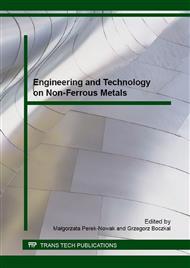p.99
p.107
p.113
p.119
p.125
p.132
p.138
p.143
p.151
Structure Analysis of Magnesium Alloy (AZ31) Wires at Different Stages of a Multistage Cold Drawing Process
Abstract:
The formability of magnesium alloys is the subject of efforts undertaken in many research centers due to their outstanding mechanical, plastic, and above all, physical properties. For this reason, magnesium alloys have become an important material which finds broad possibilities for application in many industries: automotive, electronics, aerospace and so on.The paper presents an analysis of changes in structure of AZ31 magnesium alloy wire cold-deformed in the drawing process using interoperate heat treatment. Microstructure observations of the wire by means of optical microscopy were performed in initial state, after each drawing process, and before and after heat treatment. The studies regarding the impact of selected variants of deformation on microstructure were also carried out at the scanning electron microscope (SEM).
Info:
Periodical:
Pages:
125-131
Citation:
Online since:
February 2016
Authors:
Keywords:
Price:
Сopyright:
© 2016 Trans Tech Publications Ltd. All Rights Reserved
Share:
Citation:


